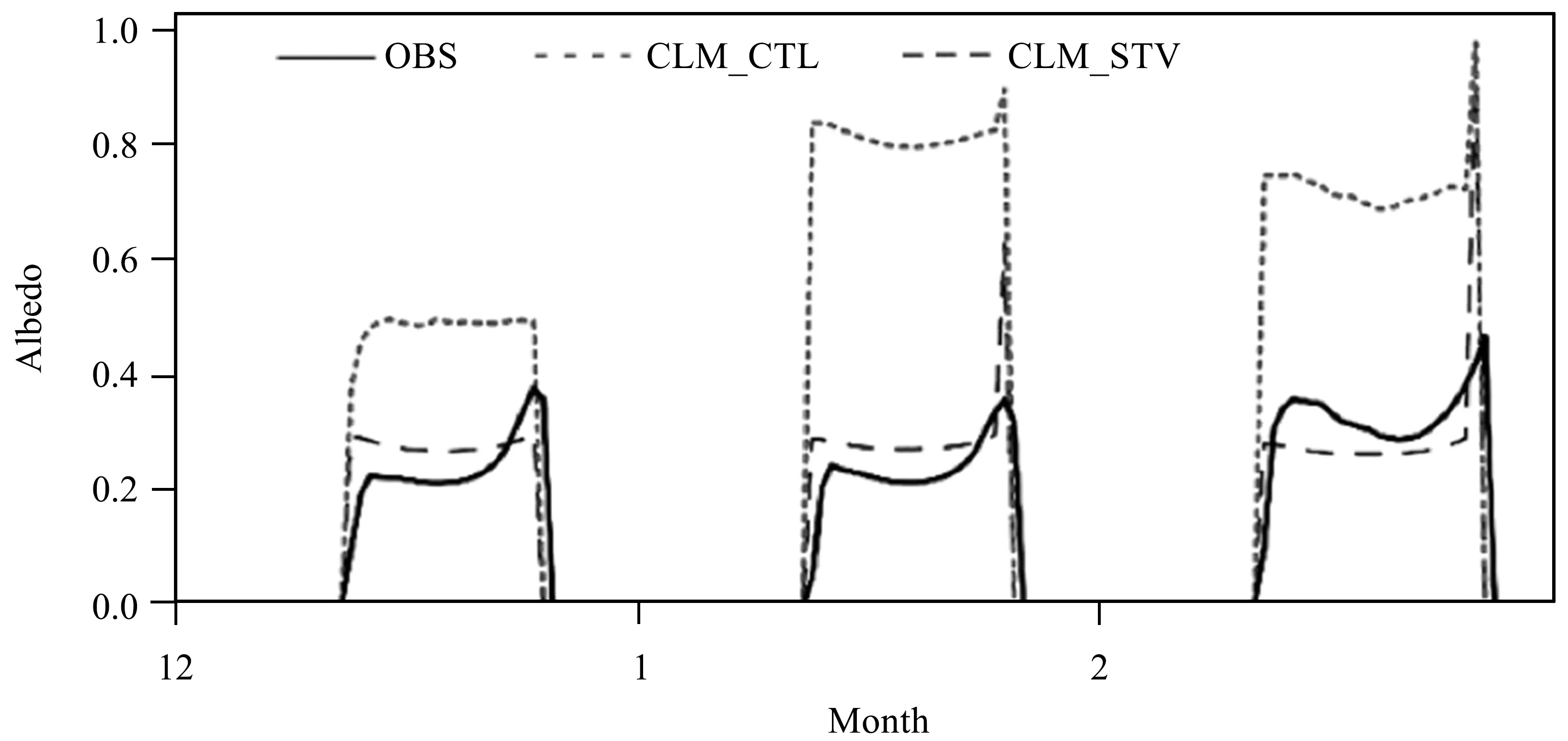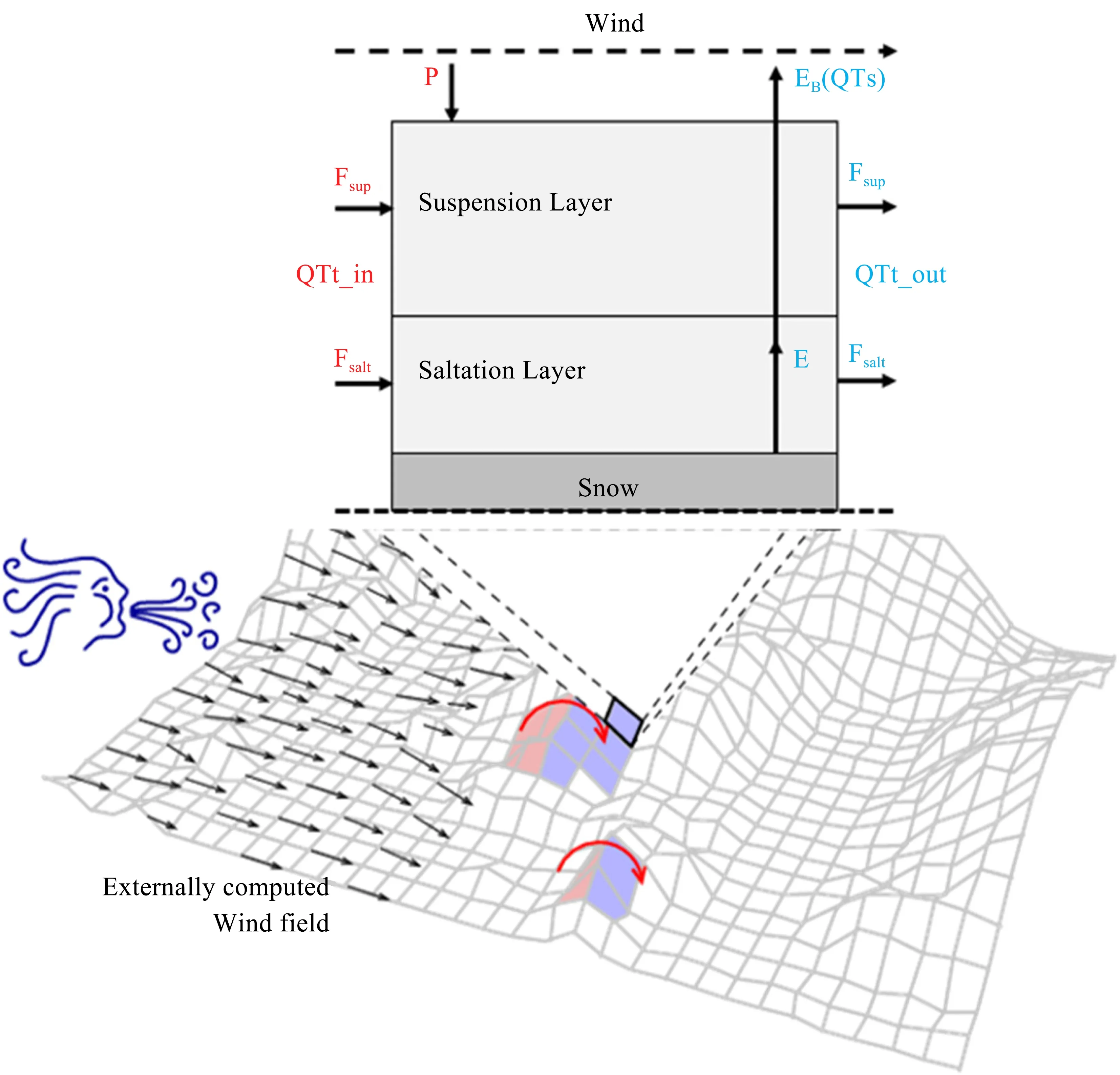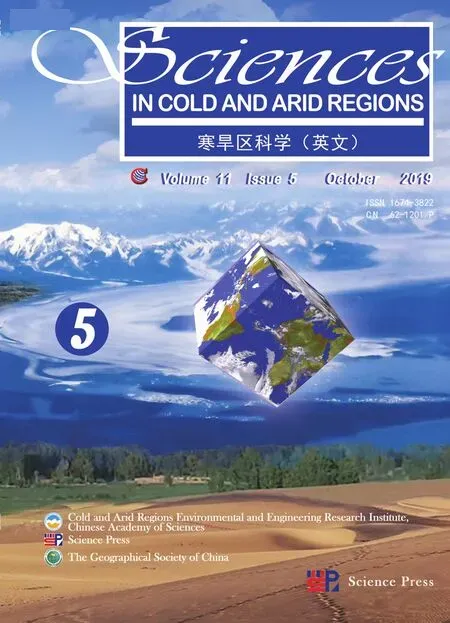Origin and advances in implementing blowing-snow effects in the Community Land Model
ZeYong Hu ,ZhiPeng Xie
1.Key Laboratory of Land Surface Process and Climate Change in Cold and Arid Regions,Northwest Institute of Eco-Environment and Resources,Chinese Academy of Sciences,Lanzhou,Gansu 730000,China
2.Key Laboratory of Tibetan Environment Changes and Land Surface Processes,Institute of Tibetan Plateau Research,Chinese Academy of Sciences,Beijing 100085,China
3.CAS Center for Excellence in Tibetan Plateau Earth Sciences,Beijing 100085,China
ABSTRACT Snow cover on the Tibetan Plateau(TP)is closely related to regional and continental biological and hydrological processes.The vast snow cover,special climatic conditions,and sparse vegetative cover over the TP facilitate the occurrence of blowing snow,leading to substantial heterogeneities in the snow cover and great promotion in the moisture supply from the land surface to the overlying atmospheric boundary layer.However,blowing-snow processes are significantly misrepresented or even neglected in current models,which causes considerable uncertainties of numerical model simulations and leads to erroneous estimates of snow-related processes in mountainous terrain.We present in this paper a brief review of our work in the past 5 years to serve as a basis for further development and improvement of the land-surface model.These studies can be divided into three parts:detection of the problems,development of the land-surface model,and application of the coupled model over the TP(the logical framework is presented in Figure 1).The origin and advances in the development of a land-surface model with consideration of blowing-snow effects are described herein;and the importance of blowing-snow processes in the land-surface model,especially over the TP,is highlighted.We expect that the blowingsnow studies over the TP will play a key role in documenting and understanding the land-surface processes(LSPs)and the cryospheric changes over the TP.
Keywords:blowing snow;land surface process;community land model;Tibetan Plateau
1 Introduction
The global land mass is crucial for the exchange of momentum,energy,and water between the land surface and its overlying atmosphere,though it accounts for only about 30%of the earth surface.Topographicrelief,heterogeneous land covers such as forest,grassland,cultivated land,snow and glaciers make the land the most complicated and important component in the climate system(Yang,2004).Land-surface processes(LSPs)refer to the basic physical and biochemical processes that occur on the land surface and shallow soil and that control the energy and mass exchanges between the atmosphere and the soil.LSPs are central in the earth system,linking the interactions between different layers of the climate system at various spatiotemporal scales,having great impact on atmospheric circulation and climate conditions (Wood, 2012).Known as the"Third Pole",the Tibetan Plateau(TP)plays an essential role in controlling regional and global climate through the tremendous thermal and mechanical forcing effect(Ye and Gao,1979;Manabe and Broccoli,1990;Yanai et al.,1992;Duan and Wu,2005).Therefore,rational description of the LSPs and accurate simulation of the land-atmosphere interactions on the TP are of great important to promote scientific understanding of the local land-atmosphere system and its effects,and hence even to the skills of weather and climate forecast operations(Zhao et al.,2018).
2 Origin of the study of blowing snow over the TP
Previous studies have indicated that the Community Land Model(CLM)is capable of providing reliable results in most areas of China(Liu and Lin,2005;Lai et al.,2014),and it is also recognized as potentially the land-surface model with the most complete parametrizations in the world.At the beginning of our study,we employed the CLM to understand the land-atmosphere interactions and the variations over the TP.We first used a full year of in-situ meteorological observations from the Naqu Climatic and Environmental observation Station to force the CLM.Then,we compared the simulated surface radiation and energy budget with the observation to assess the adaptability of the CLM in LSPs simulations on the TP(Xie et al.,2017a).By this assessment,we have a basic knowledge of the simulation ability of the CLM in high-heterogeneity regions,which can provide the basis for further improvement of the parameterization schemes in LSPs Results show that the CLM4.5 is able to reproduce the observed seasonal variations and the diurnal cycle of the surface-radiation balance(upward longwave and shortwave radiations and the net radiation)and the surface-energy budget(sensible and latent heat flux and soil heat flux)when the soil does not freeze completely,although these variables are poorly estimated in winter.By using adjusted precipitation(what falls as snow)in the sensitivity experiment,we found that the simulations of the surface radiation and energy budget are greatly improved.The fractional snow cover in simulations(usually above 0.8)significantly differed from that retrieved from the Moderate Resolution Imaging Spectroradiometer(MODIS;usually around 0.2),leading to a large bias in surface albedo when compared with in-situ observations(Figure 2).Consequently,the simulations of land-atmosphere interactions in winter are significantly influenced by the simulated snow cover.

Figure 2 The observed(OBS)and simulated(CLM_CTL and CLM_STV)diurnal variations of surface albedo in winter.CLM_CTL denotes the control simulation,and CLM_STV denotes the sensitive simulation with adjusted precipitation
Because of the significant effects of snow on the surface-energy budget and earth's radiative balance due to its high albedo and low thermal conductivity,an accurate representation of snow dynamics over the TP is important for representing the local atmospheric circulation patterns(Dickson 1984;Yang,1996)and hydrological cycle(Wu and Qian,2003).Although large-scale snow simulations over the Northern Hemisphere,or even the globe,have been implemented,great bias exists in either land-surface models or global climate models in terms of snow simulations(Wei and Dong,2015;Toureet al.,2016).The simulations of snow-related processes over the TP are far from satisfactory,and the causes of these issues are still unclear and remain to be ascertained.Therefore,by using different snow-cover schemes in CLM4.5,we performed two numerical experiments to investigate the impacts of snow-cover parameterization on the simulation of snow cover and the energy budget over the TP(Xieet al.,2018).Our work focused on snow simulations in different snow periods(snow-accumulation period,snowmelt period,and snow-free period).We aimed to find the key factor that most contributes to the great bias in modeling the spatial and temporal patterns of snow over the TP,and finally to provide the basis for seeking the potential improvement of snow parameterization.Results show that the spatial distribution of deep-snow areas can be well-estimated by both experiments when compared with the satellite-based daily snow-depth product. However, the snow depth and fractional snow cover are overestimated;and the biases are large in the snow-accumulation and snowmelt periods.The correlation between wind speed and the root-mean-square errors of snow depth are above 0.85 for the two experiments,using different snow-cover schemes.This result indicates that the biases in snow simulation over the TP are highly related to wind and its related processes.Meanwhile,in this paper,we hold the opinion that the blowing-snow processes may be crucial to the simulations of snowrelated processes over the TP.Therefore,we focus on the blowing-snow processes and their impacts on the spatial-temporal distribution of snow cover and subsequent land-atmosphere interactions,aiming to further improve the land-surface model's ability in simulating the snow hydrologic processes in alpine mountains by considering the impacts of blowing-snow processes.This approach will greatly promote the development of snow parameterization because the current mesoscale hydrological models,land-surface models,and large-scale climate models significantly misrepresent or even omit the blowing-snow processes.
3 Advances in blowing snow research over the TP
Due to the unique environmental conditions,geographical features,and diverse climate,the TP is characterized by high wind speed,together with abundant snow and low temperature during the snow-covered period,making the TP the typical area of blowingsnow activity in China (Wang and Zhang, 1999).Moreover,the short and sparsely distributed vegetation,except in the southern areas of the TP,facilitates the transport of snow particles lifted by wind.Based on snow observations in the Qilian Mountains,Liet al.(2012,2014)found that transportation and sublimation induced by blowing snow have a significant impact on the snow-mass balance.Zhouet al.(2014)showed that the simulated water equivalent of snow was overestimated in two basins of the northeastern TP if the blowing-snow module was omitted in the Cold Regions Hydrological Model platform.Our recent studies of blowing-snow simulation from 2008 to 2014 show that blowing-snow events on the TP mainly occur in winter and spring,and the main areas with blowing-snow occurrence are the central and western TP.It should be noted that the blowing-snow model in this study was driven by the CLDAS-2 dataset,as this product is the best for blowing-snow modeling over the TP,despite the occurrence of blowing-snow and snowdrift sublimation are projected to be underestimated by CLDAS-2 due to the underestimation of wind speed,the continual lack of snowfall events,and the positive biases in low temperatures and humidity(Xieet al.,2017b).The finest spatial and temporal resolutions of CLDAS-2,among the three frequently used forcing datasets in the TP,generally exhibit the smallest biases and have a relatively better performance when compared to the CMFD and MERRA-2.This work is our first step toward carrying out the study of blowing snow over the TP.We quantified the uncertainty and relative accuracy of each forcing product in terms of land-surface meteorological variables,which are critical to blowingsnow simulations, and investigated the potential propagation of uncertainties associated with each meteorological variable in modeling blowing snow in TP regions.
These above-mentioned studies highlight the importance of blowing snow over the TP;however,detailed representation of blowing-snow effects in the land-surface model or regional climate model,as well as the roles these processes play in the hydrological cycle,have rarely been investigated in cold regions of China.Based on such conditions,we developed a land-surface model that considers the impacts of blowing-snow processes(Xieet al.,2019).This study was achieved by coupling the blowing-snow module PIEKTUK with the CLM4.5(the schematic diagram of the coupled model is shown in Figure 3).The overarching scientific objectives of this study were to(1)improve the parameterization of high-mountain snow processes in CLM;(2)reduce the model's uncertainties in terms of snow processes;(3)advance understanding of wind-induced snow redistribution and its impacts on the spatial and temporal distribution of water and energy fluxes,as well as land-atmosphere interactions over the TP.Two simulations with a 0.065°spatial resolution were performed in 2010 over the TP,namely,a sensitivity experiment with the inclusion of blowing-snow effects(CLM_BS)and a control run with the original model(CLM).A specific objective of this study was to evaluate the improvements in the simulations of snow dynamics and other key variables,including surface albedo and temperature.The surface-energy partitioning was provided by the coupled model,which was evaluated by comparison with a variety of remote-sensing products,such as the MODIS snow-cover and snow-area products,the Interactive Multisensor Snow and Ice Mapping System(IMS)daily snow-cover product,the Global Land Surface Satellites(GLASS)surface-albedo product,the MODIS land-surface temperature products,and the China daily snow-depth product.Results show that CLM_BS is superior to the original CLM in reproducing the surface snow cover,snow depth,and surface albedo in most regions of the TP,particularly in the Kunlun Mountains,the Hoh Xil area,and the southwestern TP.Moreover,CLM_BS showed great ability in capturing the variations of the monthly mean snowcover fraction in areas with reduced bias.For landsurface temperature(LST),however,a significant decrease in the nighttime LST bias was detected in CLM_BS, while the bias in the daytime LST increased.Our studies showed considerable potential for promoting the modeling of snow dynamics and landatmosphere interactions over the TP by including the blowing-snow process.

Figure 3 Schematic diagram of the coupled model.Fsup and Fsalt indicate the suspended snow mass and saltated snow mass,respectively.E and EB indicate the surface-snow sublimation and blowing-snow sublimation,respectively.The colors red and blue indicate the snow mass in and out of a grid cell,respectively.The externally computed wind field used in this study is from ERA-Interim reanalysis dataset.This figure is adapted from the Alpine 3D documentation(https://models.slf.ch/docserver/alpine3d/html/model_principles.html)
4 Summary
In this series of studies,we evaluated the performance of the state-of-the-art land-surface model CLM4.5 in simulating key processes in land-atmosphere interactions over the TP,including the surface radiation and energy budget,and the snow dynamics;investigated the impacts of the snow-cover scheme on estimation of snow distribution and the surface-ener-gy budget;quantified the uncertainties of three meteorological forcing products over the TP;investigated the potential propagation of uncertainties lying in meteorological variables in blowing-snow simulation;and developed a land-surface model by considering blowing-snow processes.Overall,the research further highlighted the great importance of blowing-snow processes in the interactions between the land and atmosphere over the TP,and strengthened our confidence that a more accurate simulation of LSPs over the TP can be achieved by implementing more physically realistic parameterizations in LSPs,such as the blowing-snow processes.
Acknowledgments:
This work was supported by the Strategic Priority Research Program of the Chinese Academy of Sciences(Grant No.XDA2006010101),the National Natural Science Foundation of China(41905012,91837208 and 41661144043),the National Key Research and Development Program of China(2018YFC1505701),the Opening Fund of Key Laboratory for Land Surface Process and Climate Change in Cold and Arid Regions, the Chinese Academy of Sciences(LPCC2018002),and the China Postdoctoral Science Foundation(2018M641489).
 Sciences in Cold and Arid Regions2019年5期
Sciences in Cold and Arid Regions2019年5期
- Sciences in Cold and Arid Regions的其它文章
- Editors-in-Chief Guodong Cheng and Ximing Cai
- Analysis of chaotic climatic process in the Tarim River Basin(I)
- Seed germination and seedling growth of Pycnanthus angolensis(Welw.)Warb.,African false nutmeg
- Soil hydraulic conductivity and its influence on soil moisture simulations in the source region of the Yellow River―take Maqu as an example
- Features on N/P ratio of plants with different functional groups between two types of steppe in semi-arid area
- Qualitative and quantitative phytochemical analysis of selected mosses with different alcoholic solvents
